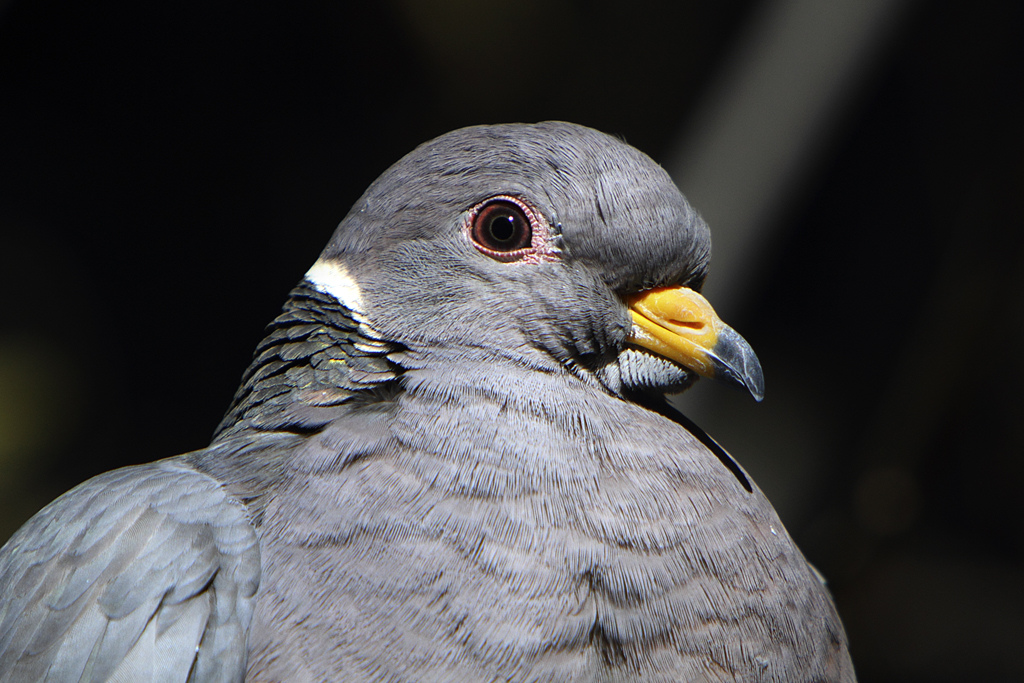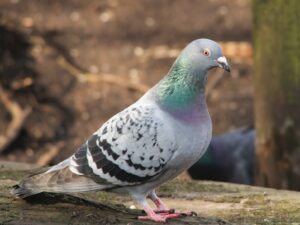Picture a pigeon and what comes to mind? Probably not a creature that most nature-lovers normally reserve much sympathy.
But what if that pigeon was a bona fide member of California’s native species list? Say, the band-tailed pigeon — a sweet, sociable member of the dove family that can travel in groups of hundreds as they descend on winter acorn crops, wherever that food source may be.
Unlike the familiar rock pigeon, a European transplant that’s done quite well for itself living amongst humans, the backwoods cousin’s population has dropped by about 2 percent a year since 1968, when the U.S. Fish and Wildlife Service began tracking the population in its annual Breeding Bird Survey.
Though it’s listed as a species of least concern, the band-tailed pigeon has had its fair share of obstacles to surmount — namely habitat loss and disease. Trichomonas gallinae, a single-celled microscopic protozoan that creates nasty, “cheese-like” lesions in the beak that eventually block the bird’s airway and esophagus, can kill off large numbers of birds. The disease may, in fact, have contributed to the decline of its closest genetic relative, the passenger pigeon.
In 2007, an outbreak killed an estimated 47,000 band-tailed pigeons in Carmel Valley. In fact, we’re in the middle of an outbreak right now, and state officials are asking the public’s help to identify dead or dying birds, and to reduce disease transmission by removing bird baths and fountains and other artificial water sources, which are a source of disease transmission.

This year, the public might even be more likely to see them as pigeons have appeared in suburban backyards in Los Gatos and Saratoga, where they haven’t been seen in more than a decade.
“They’re usually at a lot higher elevations, so people don’t encounter them as readily as this winter,” said Krysta Rogers, an environmental scientist at the California Department of Fish and Wildlife. “There is a concern that people just assume they are rock pigeons. I’d like to be clear that they are not. They are native to California, whereas rock pigeons were introduced.”

Rogers and her colleagues at CDFW and UC Davis are applying applying genetic testing methods to die-offs from these large scale mortality events to better understand what diseases avian species are carrying and how the transmission is occurring.
For example, they recently found a new strain of trichomonosis affecting the population — T. stableri. That means the birds are being hit by multiple variations of pathogens at once. Scientists don’t know for sure what triggers an outbreak of avian trichomonosis, just that it tends to cross species and be carried through water. Rock pigeons are suspected to be a source of contamination, but they usually don’t die.
Band-tailed pigeons, on the other hand, seem to be particularly affected by trichomonosis. A bird sick with parasites is slow to react and sometimes breathes with its bill open and swallows repeatedly. Because they have a relatively low reproductive rate of just one chick per year, an outbreak can hit the population hard.
“It can take a population years to recover,” Rogers said. “Some escape getting infected and some recover, but we don’t know how or why or when that occurs. That’s part of what we want to answer.”
Ultimately, Rogers and her colleagues want to know how to prevent future outbreaks to minimize mortality. They need an accurate picture of how many birds die during these events, and where the transmission might be happening.
“If we know how the disease is transmitted, it might make other things like preserving habitat more important,” she said.
Fun facts about band-tailed pigeons:
- They can swallow an acorn whole, and can suck up and swallow water without raising their heads.
- They have two distinct breeding populations, one on Pacific Coast and one in the Southwest. But there are odd-ball crossovers, like a banded Oregon bird that appeared in Florida a year later.
- They fly an average of 3 miles between nesting and feeding sites.
- Although they resemble rock pigeons, look for the long tail with a wide, pale band at the tip and a distinctive white neck crescent.



